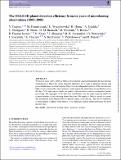The OGLE-III planet detection efficiency from six years of microlensing observations (2003–2008)
Abstract
We use six years (2003–2008) of Optical Gravitational Lensing Experiment-III microlensing observations to derive the survey detection efficiency for a range of planetary masses and projected distances from the host star. We perform an independent analysis of the microlensing light curves to extract the event parameters and compute the planet detection probability given the data. 2433 light curves satisfy our quality selection criteria and are retained for further processing. The aggregate of the detection probabilities over the range explored yields the expected number of microlensing planet detections. We employ a Galactic model to convert this distribution from dimensionless to physical units, α/au and M⊕. The survey sensitivity to small planets is highest in the range 1–4 au, shifting to slightly larger separations for more massive ones.
Citation
Tsapras , Y , Hundertmark , M , Wyrzykowski , Ł , Horne , K D , Udalski , A , Snodgrass , C , Street , R , Bramich , D M , Dominik , M , Bozza , V , Figuera Jaimes , R , Kains , N , Skowron , J , Szymański , M K , Pietrzyński , G , Soszyński , I , Ulaczyk , K , Kozłowski , S , Pietrukowicz , P & Poleski , R 2016 , ' The OGLE-III planet detection efficiency from six years of microlensing observations (2003–2008) ' , Monthly Notices of the Royal Astronomical Society , vol. 457 , no. 2 , pp. 1320-1331 . https://doi.org/10.1093/mnras/stw023
Publication
Monthly Notices of the Royal Astronomical Society
Status
Peer reviewed
ISSN
0035-8711Type
Journal article
Description
KH, DB, MD and MH are supported by NPRP grant NPRP-09-476-1-78 from the Qatar National Research Fund (a member of Qatar Foundation). KH acknowledges support from STFC grant ST/M001296/1. NK acknowledges an ESO Fellowship. The research leading to these results has received funding from the European Community’s Seventh Framework Programme (/FP7/2007-2013/) under grant agreement no. 229517. This publication was made possible by NPRP grant no. X-019-1-006 from the Qatar National Research Fund (a member of Qatar Foundation). CS received funding from the European Union Seventh Framework Programme (FP7/2007-2013) under grant agreement no. 268421.Collections
Items in the St Andrews Research Repository are protected by copyright, with all rights reserved, unless otherwise indicated.

